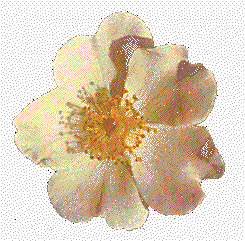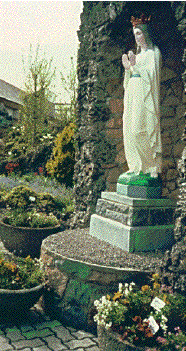John Stokes and Mary's Gardens
Garden Rosary
The Garden Way of The Rosary
– John S. Stokes Jr.

In the 12th century, St. Bernard spoke of the Blessed Virgin Mary as "The rose of charity, the lily of chastity, the violet of humility and the golden gillyflower of heaven", and, in the 13th, St. Francis of Assisi was reported to have taken care not to step on even the least flower, as it was a symbol of Mary, "The Flower of the Field"; but it is not known just when the Marian and other Christian symbolical flower names actually became widespread in the oral traditions of the European countryside. The earliest record we have found of a flower named for Mary is "Seint Mary gouldes" ("Saint Mary's Golds") included in a 1373 recipe as one ingredient of a potion sent to 'distroie the pestilence'.
We do know that Marian flower symbols must have been prevalent in Catholic culture by the 16th century because of the many Christian names given to Latin American flowers following the travels there of Spanish and Portuguese missionaries - such as the naming of the American marigold (Tagetes) from its perceived resemblance to the European Marygold (Calendula), and also the naming of the American Passion Flower (Passiflora) from its parts seen to recall Christ's lash, crown of thorns, nails of the Cross, and other instruments of his Passion symbolized individually by various European flowers. Also, in the 16th century, illustrations incorporating symbolic flowers were found, for meditation, in French and Flemish Books of Hours. From this we conclude that flower symbols of Our Lady probably had become prevalent in the countrysides by the 15th century.
It was also in the 15th century that the practice was adopted of meditating on selected Mysteries of Mary's life while praying the Aves of the Rosary. The praying of Hail Marys using prayer beads was introduced as a popular outgrowth of the praying of the 150 Psalms of the Psalter for the souls of the deceased, reported from the 8th century. For wider use, the lengthy monastic praying of the psalms was simplified by the 12th century through the praying in their place of 150 or 50 Our Fathers, on "Pater Noster" beads; and, then, in the 13th, by the praying of 150 or 50 Hail Marys in Mary's praise in the "Psalter of Our Lady". With the addition, by the 15th century, of the meditations on Mary's Mysteries, the Rosary, now prayed for general intentions, was widely promulgated in its present form through the zeal of Blessed Alan de la Roche, (c. 1428-1475).
The name "Rosary", meaning a garland or bouquet of roses, was given to the Psalter of Our Lady as a consequence of "an early legend which after traveling all over Europe, penetrating even to Abyssinia, connected this name with a story of Our Lady, who was seen taking rosebuds from the lips of a young monk when he was reciting Hail Marys and to weave them into a garland which she placed upon her head. A German metrical version of this story is still extant dating from the thirteenth century." (Catholic Encyclopedia (1912) Vol 13, p.187).
Alan de la Roche attributed the praying of the Rosary for pressing community concerns to St. Dominic, who was said by legend to have had a private revelation from Mary requesting this, and the practice soon became universal in the Church. Although scholars have found no support for the revelation of the Rosary in the writings or contemporary records of St. Dominic, this concern is now largely academic following upon Mary's appearances at Lourdes and Fatima exhorting the praying of the Rosary, in each instance holding a string of Rosary beads in her hands.
The observation by those with spiritual vision of flower "pneums" issuing and rising heavenwards from the lips of persons praying the vocal Paters and Aves of the Rosary is evidently reflected in the original Communion Verse for the Mass for the feast of the Rosary of Mary (October 7th), established in 1573:
Send forth flowers as the Lily,
and yield a fragrance,
And bring forth leaves in grace,
and praise with canticles,
And bless the Lord in his works."
Sirach 39:13-14 (Ecclesiasticus 39:18-19)

The Rosary prayer pneums, originally uttered in Mary's praises and seen as woven by her into a garland and placed on her head, are now envisaged also as petitionary prayers passing through the hands of Mary Mediatrix and, with enhancement and embellishment by her, "making our prayers hers", transported by angels to Christ and the Trinity, through whom they are graced with blessings, and then, again through her hands, returned to earth as a response of grace to the petitions prayed for. This is represented in the heavenly tableau of Mary's appearance at Knock in Ireland with her hands in special channeling position.
In the Mary Garden we have found it fitting to place the reflections quickened by the Flowers of Our Lady in the context of the fifteen mysteries of Knock Mary Garden Grotto the Rosary; and to conclude the mental Prayer engendered by them with the petition of the closing prayers of the Rosary, "that while meditating upon these mysteries of the Blessed Virgin Mary we may imitate what they contain and obtain what they promise, through Christ Our Lord. Amen"
As the three Aves at the beginning of the Rosary are employed to place the five mysteries about to be meditated on for the day in the context of the full fifteen Joyful, Sorrowful and Glorious Mysteries, so, on entering the Mary Garden, and before considering the individual symbolism of the flowers, we similarly dispose ourselves to this full meditative context as we reflect upon how all white flowers symbolize the Joyful Mysteries, red and purple flowers the Sorrowful Mysteries, and yellow and gold flowers the Glorious Mysteries.
Then, as we draw closer to the flowers, we are reminded by their beauty of the beauty of Mary's holiness as "Flower of flowers" (Chaucer); and by their spotless, translucent purity of her immaculate spiritual purity through which she was open to the fullness of grace - bestowed in accordance with God's desire, will and plan for all creation, and especially for humans created to this end in the divine image and likeness, to share, show forth and participate to the fullest in the divine goodness and creating, saving, and sanctifying action.
Finally, as we behold each flower, we reflect and meditate on the particular mystery or aspect of Mary's life it symbolizes (see the accompanying article, "Flower Theology.") - praying that we may imitate Mary's virtues, excellences and holiness mirrored by it, and then, through her sure petitions, intercession and mediation, obtain the graces it promises, as shown forth in all fullness in her.
It is fitting that the religious flower symbolism of nature and that of the Rosary are reunited at Knock, where the Mary Garden planted at the Blessed Sacrament Chapel in 1983 is believed to be the first established at a national Marian Shrine, and following upon which the entire grounds have been planted with flowers, making the whole shrine, as it were, a Marian Meadow.
Copyright Mary's Gardens 1995
The John Stokes and Mary's Garden collection was transferred to the Marian Library in May 2013. In addition to his archives, manuscripts, artwork, and personal library, John S. Stokes also donated his extensive website. It was transferred to the Marian Library in 2010. This particular entry is archived content original to Stokes' Mary's Gardens website. It is possible that some text, hyperlinks, etc. are outdated.